Gregory A. Fournier's Blog, page 31
August 25, 2015
Ypsilanti, Michigan History - What's in a Name?
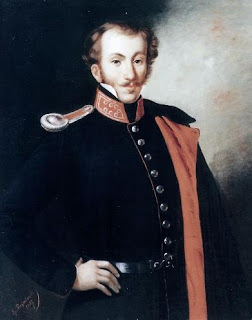 Dimitrios YpsilantisWhere the ancient Native American trail crossed the narrows at a bend of the Huron River, Gabriel Godfroy--a French-Canadian fur trader from Montreal--established his Indian trading post in 1809. Fifteen years later, Judge Augustus B. Woodward of Detroit with two local land speculators--William Harwood and John Stewart--laid-out a town on land they purchased from the original French settlers.
Dimitrios YpsilantisWhere the ancient Native American trail crossed the narrows at a bend of the Huron River, Gabriel Godfroy--a French-Canadian fur trader from Montreal--established his Indian trading post in 1809. Fifteen years later, Judge Augustus B. Woodward of Detroit with two local land speculators--William Harwood and John Stewart--laid-out a town on land they purchased from the original French settlers.Judge Woodward was a Grecophile who wanted to name the town in honor of Greek war hero Demetrius Ypsilanti--a general famous for successes in his country's war for independence against the Ottoman Turks. This struck a chord with Woodward. America had waged its own war for independence against the British not so very long before.
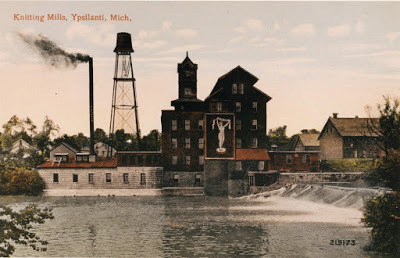 Ypsilanti Woolen Company
Ypsilanti Woolen CompanyHis partners had a different idea with more commercial potential. They favored a name like Waterford or Waterville which highlighted the water-power feature of the Huron River to attract manufacturing business. Judge Woodward--being the major investor in the land project--had the final word. In 1824, the new town of Ypsilanti spanned both sides of the Huron River on the old Chicago Road (soon to be renamed Michigan Avenue). An area which began as a frontier trading outpost eventually became downtown Ypsilanti.
The east side of Ypsilanti developed when the Michigan Central train line began rail service in 1838, making the city an important economic hub for the area’s growing light-industry and agricultural concerns. A lovely, three-story train depot said to be the nicest depot between Detroit and Chicago was built in 1864. A two block long commercial district grew up along both sides of East Cross Street—aptly named Depot Town.
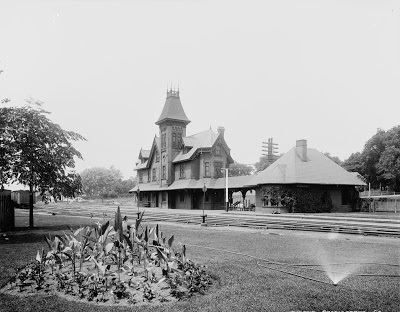 Original Ypsilanti train depot with landscaping.The Depot Town businesses on the ground floors catered to the needs of weary travelers and light manufacturing. The upper floors were used for lodging, warehousing, or residential use. Depot Town was a destination for the Underground Railroad before and throughout the Civil War. Soldiers of the 14th and 17th Michigan Regiments left for the South from the Ypsilanti train station platform.
Original Ypsilanti train depot with landscaping.The Depot Town businesses on the ground floors catered to the needs of weary travelers and light manufacturing. The upper floors were used for lodging, warehousing, or residential use. Depot Town was a destination for the Underground Railroad before and throughout the Civil War. Soldiers of the 14th and 17th Michigan Regiments left for the South from the Ypsilanti train station platform.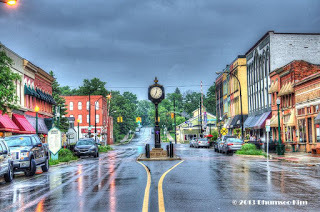 Depot Town TodayA fire destroyed the tower and the upper floors of the depot in May of 1910. New owners--Pennsylvania Central Railroad--decided to rebuild only the ground floor. Amtrak ended passenger service in 1982.
Depot Town TodayA fire destroyed the tower and the upper floors of the depot in May of 1910. New owners--Pennsylvania Central Railroad--decided to rebuild only the ground floor. Amtrak ended passenger service in 1982.There may be some life in the old girl yet. Depot Town could be a stop on the proposed Ann Arbor to Detroit commuter rail line which would bring more activity into the area. Restoring the Depot Town train buildings preserves a remnant of Ypsilanti's history which could be re-purposed on the interior to increase the commercial value of the property.
I can envision a fine dining, Victorian-styled restaurant. Maybe a seafood restaurant. How about a sushi bar or an Asian noodle shop? Something that doesn't take business away from Frenchie's Sidetrack Bar & Grill or Aubrey's Pizzeria & Grill. Ypsilanti's very own Gandy Dancer or something similar would be nice.
http://visitypsinow.com/museums/
Published on August 25, 2015 06:58
August 19, 2015
Up and Down with The Three Stooges
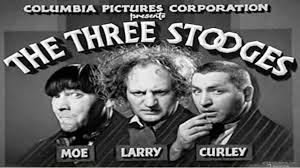
Known for farce and slapstick comedy, The Three Stooges began their career in 1925 as second bananas to vaudeville comedian Ted Healy. The original trio consisted of Moe (Moses) Howard, Shemp (Samuel) Howard, and Larry (Louis Feinberg) Fine--collectively known as Healy's Stooges.
In 1932, Shemp left the act because he was fed up with Healy's alcoholism and abusive behavior. He pursued a successful solo career with Vitaphone Pictures in Brooklyn, New York--his hometown. The boys needed a quick replacement, so Moe suggested his younger brother Jerome.
Healy took one look at Jerome and said he didn't look funny. Jerome was too well-dressed and had a full head of chestnut-colored, wavy hair. Jerome left the room saying he would be back in several minutes. He returned with a freshly shaved head and a star was born. Jerome was given the stage name Curly. He was the original "chowderhead" and most popular of the Stooges. Untrained but with a flair for physical comedy, Curly's child-like mannerisms and natural comedic charm made him a fan favorite.
The team signed a contract with Metro-Goldwyn-Mayer lasting one year. Healy and his Stooges played bit parts of comic relief in half a dozen B-grade movies. The Stooges split with Ted Healy in 1934 and signed a one year contract with Columbia Pictures to appear in eight comedy short-subjects within a forty week period. The trio was paid $7,500 per film to divide among themselves.
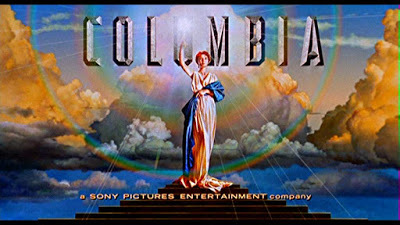
During their twenty-three years at Columbia Pictures, Moe Howard managed The Three Stooges--as they were now known. Moe was never fully aware of The Three Stooges' wild popularity at the box office or their income-earning potential. Every year, the boys had to sweat out whether they had a job or not. Studio mogul Harry Cohn complained the market for movie shorts was dying out. Moe never negotiated for a salary increase--nor were they ever offered one.
When The Three Stooges stopped making shorts in 1957, Moe finally realized what cash cows they were for Columbia Pictures. It was their cheap-to-make, two-reelers that kept the studio's gates open during the Great Depression and World War II.
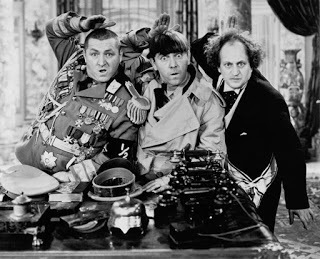 The Three Stooges shorts satirized greed, high society, health care, crime, the Depression, and World War II. The Stooges were the first Americans to take on Adolph Hitler and the Nazis. On January 19, 1940, Larry, Moe, and Curly ridiculed the German dictator in You Natzy Spy. Although not considered one of their finer efforts, it would be almost two years before the United States' entrance into World War II.
The Three Stooges shorts satirized greed, high society, health care, crime, the Depression, and World War II. The Stooges were the first Americans to take on Adolph Hitler and the Nazis. On January 19, 1940, Larry, Moe, and Curly ridiculed the German dictator in You Natzy Spy. Although not considered one of their finer efforts, it would be almost two years before the United States' entrance into World War II.In the 1940s, Curly's weight ballooned from overeating and drinking. By 1945, Curly had trouble remembering his lines. He was lethargic. His voice was deeper and strained. He couldn't do the high-pitched woo-woos and n'yuk-n'yuks anymore--doctors discovered Curly had had a minor stroke. A massive stroke the following year ended his fourteen-year-long career. At the end, Curly could only communicate with Moe by squeezing his hand or blinking his eyes. Jerome (Curly) Howard died in 1952 of a cerebral hemorrhage at age forty-eight. He appeared in ninety-seven Columbia shorts.
Moe asked his older brother Shemp to reprise his role as an original Stooge. He had a successful solo career but returned in 1947 to keep the act alive. After Curly's last few sluggish performances, Shemp injected some zany vitality into the series. Larry Fine was also given more screen time.
Shemp was with the act when The Three Stooges made their first television appearance on Milton Berle's Texaco Star Theater in 1948. Their slapstick brand of short sketch comedy was well-suited for variety shows. Because there was no backlog of television programming, they were in great demand to fill air time. The Three Stooges became reacquainted with their core audience. Three years after Curly passed, Shemp died of a massive heart attack at age sixty in 1955. He appeared in seventy-seven episodes.
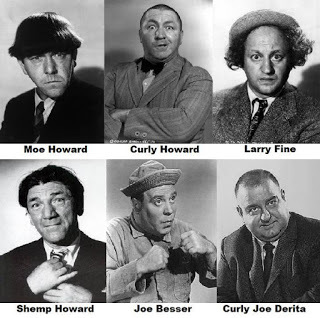 Moe Howard and Larry Fine lived for twenty more years and continued to work with several other replacements. Larry died of a stroke at age seventy-two in January 1975; Moe died of lung cancer at age seventy-seven in May 1975.
Moe Howard and Larry Fine lived for twenty more years and continued to work with several other replacements. Larry died of a stroke at age seventy-two in January 1975; Moe died of lung cancer at age seventy-seven in May 1975.In January of 1955, Screen Gems--a Columbia Pictures television subsidiary--began packaging The Three Stooges for the television market. Because of the large body of material--190 shorts--shows were broadcast Monday through Friday in syndication across the country. This heavy exposure led to a new generation of Stooge fans--the Baby Boomers.
Although The Three Stooges were never a hit with critics, they outlasted all their contemporaries. They are beloved by generations of Americans and respected for their large body of work. In 2000, ABC aired a made-for-television The Three Stooges bio-pic telling their story through the eyes of Moe Howard. I thought it was quite good. Evan Handler played Larry, Paul Ben-Victor played Moe, Michael Chiklis played Curly, and John Kassir played Shemp.
In 2012, Twentieth Century Fox released their Three Stooges movie to a world-wide audience reigniting the global popularity of one of the greatest celebrity brands. This film is divided into three episodes--similar to how the shorts were packaged for television--and attempts to recreate the classic act.
The list of supporting actors is impressive: Jane Lynch, Sofia Vergara, Jennifer Hudson, Kate Upton, Larry David, among others. The first movie was successful enough to warrant a sequel. On May 7, 2015, Fox studio announced that Sean Hayes as Larry, Will Sasso as Curly, and Chris Diamantopoulos as Moe will reprise their roles.
Hardcore Three Stooges' fans will find the following Larry Fine interview fascinating.
1973 Larry Fine interview (part one):
https://www.youtube.com/watch?v=B3x-uDXBllw
Larry Fine interview (part two):
https://www.youtube.com/watch?v=CFR2RKAU_bo
Published on August 19, 2015 05:27
August 12, 2015
Detroit Athletic Club Turns One Hundred
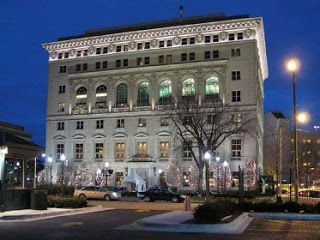 The Detroit Athletic Club (DAC) is a private social club in the sports and entertainment district of downtown Detroit. Its doors opened April 24th, 1915. The club celebrated its centennial this year with the dedication of a 2.3 million dollar sculpture project commemorating the club's original mission--supporting amateur athletes.
The Detroit Athletic Club (DAC) is a private social club in the sports and entertainment district of downtown Detroit. Its doors opened April 24th, 1915. The club celebrated its centennial this year with the dedication of a 2.3 million dollar sculpture project commemorating the club's original mission--supporting amateur athletes.Henry Ford's renowned architect Albert Kahn designed the six-story Italian Renaissance Revival building which boasts a grand staircase, a hotel, meeting rooms, a ballroom, banquet facilities,restaurants, Grill Room bar, exercise facilities, a lap pool, a gymnasium, a basketball court, a spa, an eight lane bowling alley, and a glass enclosed rooftop lounge with a cigar bar.
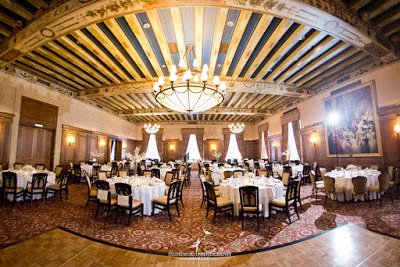 Banquet/BallroomMany Metropolitan Detroit residents are unfamiliar with this Detroit institution, located at 241 Madison Avenue on the corner of John R. Street. Today, DAC claims forty-four hundred members from two thousand companies. Twenty-nine hundred resident members have voting rights and--at last report--pay a $3,500 entrance fee and $300 to $400 dues per month, depending on the level of membership. The club has four hundred intermediate members (ages 21-33) and eleven hundred non-resident members scattered around the country and internationally.
Banquet/BallroomMany Metropolitan Detroit residents are unfamiliar with this Detroit institution, located at 241 Madison Avenue on the corner of John R. Street. Today, DAC claims forty-four hundred members from two thousand companies. Twenty-nine hundred resident members have voting rights and--at last report--pay a $3,500 entrance fee and $300 to $400 dues per month, depending on the level of membership. The club has four hundred intermediate members (ages 21-33) and eleven hundred non-resident members scattered around the country and internationally.The DAC survives on membership dues and new growth. The club encourages the families of its members to participate in club events and fundraisers. The sons and daughters of Detroit's business elite comprise a good portion of DAC's intermediate membership. Their children benefit from this arrangement as they have for generations.
Henry Ford was an original member, as has every generation of his descendants since. The DAC has been the most prominent locale for Detroit's business power-brokers to network with the city's movers and shakers. The club's founding members once controlled ninety percent of the world-wide automobile business. Many of the economic decisions affecting the Detroit area were discussed over cocktails at these exclusive gatherings.
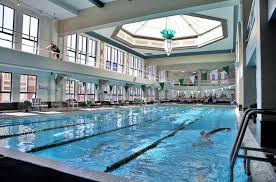 Olympic-sized lap pool.
Olympic-sized lap pool.During much of DAC's history, Jews, African-Americans, and women were denied membership. One by one, those barriers were overcome. In 1986, women were finally admitted and currently make up twelve percent of the club's members. Today's club is trying to shed its good old boy heritage.
A strict application process is in effect. Potential members must have a sponsor, six members to write recommendation letters, an intensive interview, and approval by DAC's membership committee. This private club reserves the right to deny membership to anyone.
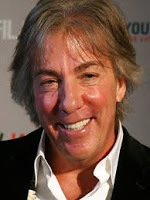 Geoffrey FiegerEarlier this year, Geoffrey Fieger--best known as Dr. Jack Kevorkian's lawyer--was summarily rejected after filing for club membership. Fieger's sponsor delivered the bad news personally. The DAC never sent a formal letter of rejection nor was Fieger told why he did not measure up.
Geoffrey FiegerEarlier this year, Geoffrey Fieger--best known as Dr. Jack Kevorkian's lawyer--was summarily rejected after filing for club membership. Fieger's sponsor delivered the bad news personally. The DAC never sent a formal letter of rejection nor was Fieger told why he did not measure up.When asked why he was rejected, Fieger commented, "The DAR has a long history of bigotry, and I'm a lawyer for the underdog. The club's hierarchy are deeply ensconced in that old tradition."
Published on August 12, 2015 06:48
July 27, 2015
The Rainy Day Murders Reincarnation

I think about this Robert Frost poem every time I'm asked if The Rainy Day Murders will be finished soon. "The Armful" sums up where I'm at in the writing process.
The Armful For every parcel I stoop down to seize
I lose some other off my arms and knees,
And the whole pile is slipping, bottles, buns --
Extremes too hard to comprehend at once,
Yet nothing I should care to leave behind.
With all I have to hold with hand and mind
And heart, if need be, I will do my best
To keep their building balanced at my breast.
I crouch down to prevent them as they fall;
Then sit down in the middle of them all.
I had to drop the armful in the road
And try to stack them in a better load.
After seeking advice from several editors, I've decided to restructure the story to strengthen the narrative and sharpen the focus. I'm considering a change of title also.
The only realistic answer to the question--"When will your manuscript be finished?"--is when I master the material rather than it mastering me. The sooner, the better--but not until it is ready.
Published on July 27, 2015 06:58
July 20, 2015
Bald Barbie Doll
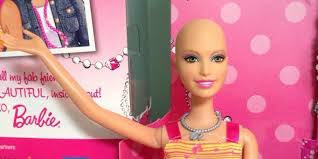
My wife wrote Mattel Consumer Services last January suggesting that their company produce a bald Barbie doll for young cancer patients. We were quite moved by Mattel's response and want to share this rare look into Mattel's corporate heart.
From: Mattel Consumer Services [mailto:MattelConsumerService@Mattel.com] Sent: Thursday, January 15, 2015 12:08 PM To: [address omitted] Subject: In Reference to Case Number: 23107550
Hi Susan,
We are honored that you believe that Barbie could be the face of such an important cause. Mattel appreciates and respects the passion that has been
built up for the request for a bald Barbie doll.
Play is vital for children, especially during difficult times.We are pleased to say that in 2013 we produced a fashion doll, Ella friend of Barbie,and she included wigs, hats, scarves and other fashion accessories to provide girls with a traditional fashion play experience.For those girls
who choose, the wigs and head coverings can be interchanged or completely removed.We will work with our longstanding partner, the Children's Hospital Association,to donate and distribute the dolls exclusively to children's
hospitals directly reaching girls who are most affected by hair loss. A limited number of dolls and monetary donations will also be made to CureSearch for Children's Cancer and the National Alopecia Areata Foundation.
Through a thoughtful approach, we made the decision not to sell these dolls at retail stores, but rather get the dolls directly into the hands of children who can most benefit from the unique play experience, demonstrating Mattel's ongoing commitment to encourage play as respite for children in the hospital and to bring joy to children who need it most.We appreciate the conversation around this issue, and thank you for contacting us to provide
your feedback!
Thanks,
Sally
Consumer Services AssociateLinks to:The Children's Hospital Association - https://www.childrenshospitals.org/Curesearch for Children's Cancer - http://curesearch.org/National Alopecia Areata Foundation - https://www.naaf.org/
Published on July 20, 2015 07:08
July 11, 2015
The Old Globe Theatre Celebrating Eighty Years in San Diego
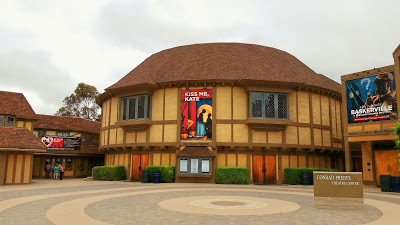 Conrad Prebys Theater Centre
Conrad Prebys Theater CentreSan Diego's Old Globe Theater was originally built in 1935 as part of the California Pacific International Exposition in Balboa Park. The building was saved from the wrecking ball in 1937 by a local community theater group for $500. The restoration of the theater was a labor of love for the volunteers who worked and performed there until the outbreak of World War II.
During the war years--and for several years afterward--the Globe's stage was dark, except for USO shows broadcast nationally and overseas on Armed Services Radio for the troops. It was not until 1949 that the Old Globe re-instituted its annual Shakespeare Festival with a production of Twelfth Night.
The Old Globe began hiring professional Equity Actors in1959 attracting top talent like Christopher Walken, Michael Learned, Christine Ebersole, Robert Foxwood, Christopher Reeve, and David Ogden Stiers to name only a few. The roll call of fine actors who have graced the Old Globe's stage reads like a Who's Who of American actors.
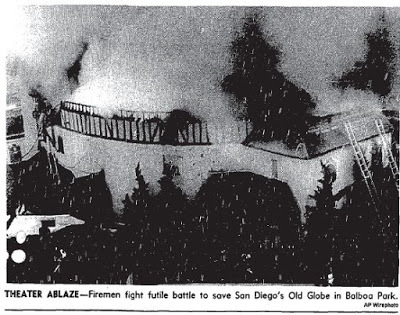
Arson fire destroyed the Old Globe building on March 8th, 1978. The loss of their beloved theater hit the San Diego community hard. But the show must go on! The play running at the time was relocated downtown to the Spreckle's Theater--so it could complete its run. An outdoor structure was quickly built on an adjacent canyon hillside which was ready for the Old Globe's Summer Shakespeare Festival several months later.
The San Diego community rose to the call to rebuild the Old Globe. Fundraising events were held throughout San Diego ranging from blind auctions to Jazzercise marathons. Combined with business support and private endowment funding, the Old Globe was reborn in 1982. The state-of-the-art modern theater opened with a production of Shakespeare's As You Like It.
Two years later, the temporary outdoor Festival Stage also fell victim to arson. It was immediately replaced with the 612 seat Lowell Davies Festival Theatre in 1985.
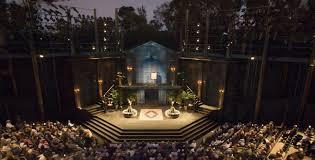 The Festival StageToday, the Conrad Prebys Theatre Centre includes the Old Globe Theatre, a proscenium arch stage; the Sheryl and Harvey White Theater, a theater-in-the-round stage; and the Lowell Davies Festival Theatre, an outdoor amphitheater stage.
The Festival StageToday, the Conrad Prebys Theatre Centre includes the Old Globe Theatre, a proscenium arch stage; the Sheryl and Harvey White Theater, a theater-in-the-round stage; and the Lowell Davies Festival Theatre, an outdoor amphitheater stage.Built adjacent to the Old Globe are the box office, gift shop, administrative offices, and rehearsal halls. Lady Caroline's Pub lies between the White and the Festival theaters and helps frame the plaza welcoming a quarter of a million patrons to the complex annually.
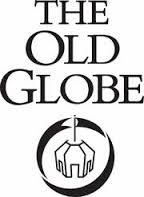 In addition to Shakespeare's plays, the Old Globe produces a broad array of modern, classic, and original works. Fifteen plays hit the Globe's boards every year. Several of their debut productions have gone to Broadway winning Tony Awards. What began as a community theatrical enterprise has become a top-rated, nationally respected regional theater.
In addition to Shakespeare's plays, the Old Globe produces a broad array of modern, classic, and original works. Fifteen plays hit the Globe's boards every year. Several of their debut productions have gone to Broadway winning Tony Awards. What began as a community theatrical enterprise has become a top-rated, nationally respected regional theater.To contact the Old Globe in San Diego tap http://www.theoldglobe.org/?gclid=Cj0KEQjw2v2sBRCazKGu3tSFz64BEiQAKIE1hmAT8fN_kei9eY0LBpDNv1gexCXUY_dA-ZUbXkBCqZYaAnIW8P8HAQ
Preview scenes from this summer's 2015 Old Globe musical production of Kiss Me. Kate. https://www.youtube.com/watch?v=mTckOI2t21s
Published on July 11, 2015 06:56
July 8, 2015
The Old Globe Theatre Celerabrating Eighty Years in San Diego's Balboa Park

Scenes from this summer's 2015 Old Globe musical production of Kiss Me. Kate. https://www.youtube.com/watch?v=mTckOI2t21s
Published on July 08, 2015 19:13
July 2, 2015
Conan O'Brien Hosts Week of Comic-Con Shows from San Diego--July 8th-11th
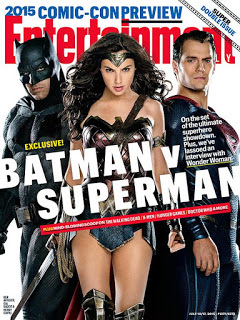 The San Diego Comic-Con International--known simply as Comic-Con--is a four-day event held during the summer at the San Diego Convention Center in lovely Southern California. This year's event takes place July 9-12.
The San Diego Comic-Con International--known simply as Comic-Con--is a four-day event held during the summer at the San Diego Convention Center in lovely Southern California. This year's event takes place July 9-12. Three hundred comic book enthusiasts attended Comic-Con's first event held at the U.S. Grant hotel in 1970. Organizers soon discovered that working with groups like the Society for Creative Anachronism and the Mythopoeic Society broadened its fan base and attracted a lot of new talent to their event. For the last several years, the gathering at the San Diego Convention Center has been at full capacity with 130,000 participants. The economic impact on San Diego is $180 million.
In the beginning, Comic-Con showcased primarily comic books and science fiction related items, but soon expanded to include a wide range of pop culture including animation, anime, collectible memorabilia, video games, web comics, and fantasy merchandise.
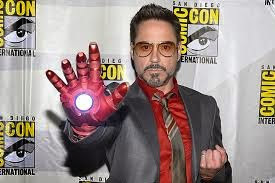 Tony Stark makes an appearance at Comic-Con.Popular sponsored events include panel discussions, seminars, and workshops with comic book artists and writers. There are feature film previews and an independent film festival for movies and shorts without a movie deal. Film and television personalities attend this convention to create a buzz about their upcoming projects and take full advantage of the extensive media exposure.
Tony Stark makes an appearance at Comic-Con.Popular sponsored events include panel discussions, seminars, and workshops with comic book artists and writers. There are feature film previews and an independent film festival for movies and shorts without a movie deal. Film and television personalities attend this convention to create a buzz about their upcoming projects and take full advantage of the extensive media exposure.Comic-Con began awarding their Inkpot Award in 1974 to persons of interest in the Popular Arts industry. In 1988, organizers established the Will Eisner Award--named after the pioneering comic book writer and artist. Winners comprise the comic industry's Hall of Fame. Comic-Con has a large ballroom for exhibitors and an Artists' Alley for autographs and photo-ops from artists, writers, and celebrities.
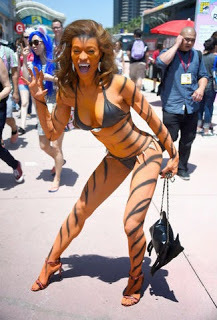 TigraOne of the standout features of Comic-Con are the costumes worn by many of the participants and the masquerade contest to determine the year's best. The spectacle is nothing less than Halloween on steroids. No shortage of superheroes, villains, plum smugglers, and buxom beauties.
TigraOne of the standout features of Comic-Con are the costumes worn by many of the participants and the masquerade contest to determine the year's best. The spectacle is nothing less than Halloween on steroids. No shortage of superheroes, villains, plum smugglers, and buxom beauties.The San Diego gathering is the Mecca of Geekdom. This year, their king--Conan O'Brien--will host a week of shows from San Diego's historic Spreckles Theatre. Rather than begining the week with Monday and Tuesday night's shows, Conan's week will begin Wednesday night and run through Saturday. Episodes will air on TBS at 11:00 PM nationwide and across their mobile and digital platforms the following day.
 Conan O'BrienGuests already announced are the casts of Hunger Games, Game of Thrones, and The Walking Dead. Saturday night's line-up is a secret--making me think it might be the cast of next year's Batman v Superman. I'll have to tune-in to find out.
Conan O'BrienGuests already announced are the casts of Hunger Games, Game of Thrones, and The Walking Dead. Saturday night's line-up is a secret--making me think it might be the cast of next year's Batman v Superman. I'll have to tune-in to find out. Comic-Con is suffering from its own success and has outgrown the present San Diego Convention Center facility. Because of overcrowding, organizers have capped attendance since 2007. In October 2013, the San Diego Coastal Commission approved a $520 million expansion to add another 225,000 square feet to the facility.
A new 80,000 square foot ballroom is planned, and a second tower will be added to the Hilton Bayfront Hotel adjacent to the convention center increasing its capacity by 500 rooms. Comic-Con is expected to remain in San Diego for many years to come.

Comic-Con 2015 is already sold out, so begin planning for 2016. Information about obtaining an authorized Member I.D. number and purchasing tickets for next year's event can be found at this link: http://www.comic-con.org/cci/purchase-badges
Published on July 02, 2015 08:00
June 29, 2015
Twelfth Night--Gender Bending at The Old Globe in San Diego
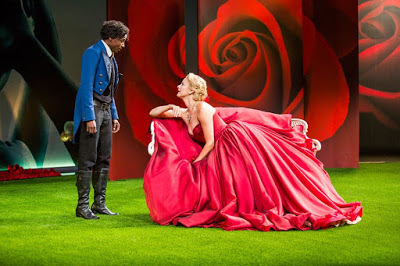
The Old Globe Theater's opening night of Twelfth Night--Shakespeare's gender bending romantic comedy--couldn't have been more timely given the recent Gay Marriage Supreme Court ruling. With the GLBT banner waving from the California Tower in Balboa Park, these talented actors--under the skillful direction of Rebecca Taichman--brought that madness we call love, in all its ridiculous splendor, to the outdoor Festival Stage in San Diego.
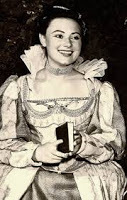
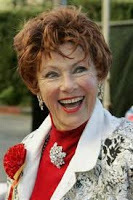 My wife and I attended an Old Globe fund raising dinner before the show with many of San Diego's theater glitterati in attendance, not least of whom was Marion Ross of Happy Days fame. Miss Ross is a local San Diego girl who first appeared on the Old Globe Festival stage in 1949 as Olivia in Twelfth Night. Miss Ross was seated directly in front of us and intently focused on the performance. I caught her quietly reciting the lines a couple of times.
My wife and I attended an Old Globe fund raising dinner before the show with many of San Diego's theater glitterati in attendance, not least of whom was Marion Ross of Happy Days fame. Miss Ross is a local San Diego girl who first appeared on the Old Globe Festival stage in 1949 as Olivia in Twelfth Night. Miss Ross was seated directly in front of us and intently focused on the performance. I caught her quietly reciting the lines a couple of times.As she was walking up the aisle at play's end, I offered her my arm for the long trek up the stairs. She smiled and said, "Please."
I'm hear to tell you that Mrs. C. is just as charming in person as she was when she appeared in America's living rooms with Richie and the Fonze.
For still photographs from the performance, check this link:
https://www.facebook.com/TheOldGlobe/photos/ms.c.eJxd0MkJwEAMQ9GOgj1e1X9jgVzC~;OtDyMJuXhE9vV2pKHv8l2hKdd4yGRQVZJc9at0ZWc6dUdhhZg0ZE~_VoKc6ebKeE87qwWTUFSXFz5aC52iAdvD7FhRP8zw4zG0nJ~_~;Njfr7NLxxZYgM~-.bps.a.10153315337154350.1073741897.8498549349/10153367686549350/?type=1&theater
Published on June 29, 2015 12:41
June 17, 2015
Detroit's Edgewater Park--A Fading Memory
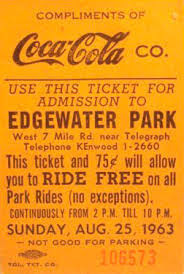 Pay-One-Price TicketThe Rouge River ran behind Edgewater Park--a twenty-acre amusement park on the West Side of Detroit. The park opened in 1927 on West 7 Mile Road and Grand River--just in time for Depression and World War II generations to escape the dire headlines while having some fun and diversion during hard times.
Pay-One-Price TicketThe Rouge River ran behind Edgewater Park--a twenty-acre amusement park on the West Side of Detroit. The park opened in 1927 on West 7 Mile Road and Grand River--just in time for Depression and World War II generations to escape the dire headlines while having some fun and diversion during hard times. Throughout the 1950s and 1960s--my era--the amusement park was one of the most popular recreation spots in the Detroit area. When we were kids, my parents took us to the park every year or so, but when my friends and I started to drive, Edgewater park was a regular after dark destination. We drove north up Telegraph Road from Dearborn Heights. It took no time at all to get to this oasis of affordable amusement and cheap thrills.
Popular rides and attractions were the one-hundred and ten foot tall Ferris Wheel with its great neon lighting effect at night, the Wild Mouse that would give riders whiplash, the always popular Dodge-Em cars, the reality-altering Hall of Mirrors, and the Fun House where many a male got to first base for the first time.
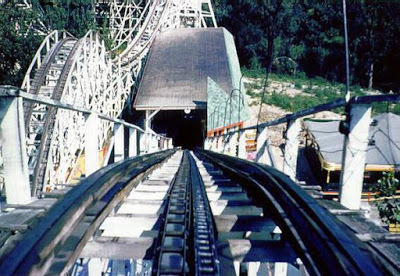 Clicking and clacking before The Beast's first drop.Edgewater Park's premiere ride was a wooden roller coaster named "The Wild Beast." During the days of Pay-One-Price admission, some riders would see how many consecutive times they could ride The Beast in a day. I remember riding it seventeen times and having bruises all over my body afterward. One person claims to have ridden it twenty-seven times in one day, but I'm not certain how many of those rides were pre- or post- mortem. He must have worn protective clothing. The real record is lost to history.
Clicking and clacking before The Beast's first drop.Edgewater Park's premiere ride was a wooden roller coaster named "The Wild Beast." During the days of Pay-One-Price admission, some riders would see how many consecutive times they could ride The Beast in a day. I remember riding it seventeen times and having bruises all over my body afterward. One person claims to have ridden it twenty-seven times in one day, but I'm not certain how many of those rides were pre- or post- mortem. He must have worn protective clothing. The real record is lost to history.In the 1960s, the Teen Scene became a popular weekend spot. Admission to the park and the concert were included in the ticket price. Popular Motown groups often appeared at the park--as did the likes of Del Shannon and David Cassidy. Corn dogs, Coney dogs, cotton candy, and real French fries with malt vinegar drew teens to the park in huge numbers.
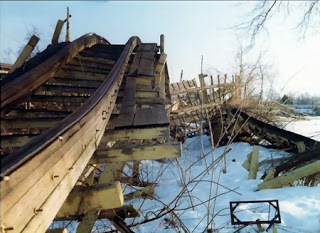 Roller Coaster RuinsDeclining revenues and competition from other amusement parks like Bob-Lo Island in the Detroit River and Cedar Point in Sandusky, Ohio proved to be more than the old park could handle. The last click of the turnstile was on September 13, 1981. The park operated for fifty-four years, but little is known of its history. Today, the site is home to the Greater Grace Temple.
Roller Coaster RuinsDeclining revenues and competition from other amusement parks like Bob-Lo Island in the Detroit River and Cedar Point in Sandusky, Ohio proved to be more than the old park could handle. The last click of the turnstile was on September 13, 1981. The park operated for fifty-four years, but little is known of its history. Today, the site is home to the Greater Grace Temple.Photos of Edgewater Park: http://photos.metrotimes.com/15-nostalgic-photos-of-detroits-old-edgewater-amusement-park/#16
Published on June 17, 2015 06:19



